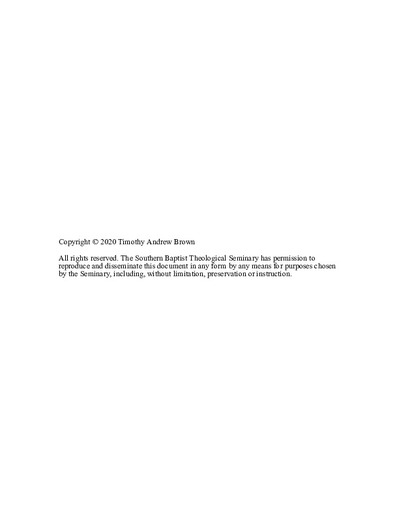| dc.contributor.advisor | Hamilton, James M. | |
| dc.contributor.author | Brown, Timothy Andrew, 1985- | |
| dc.date.accessioned | 2020-05-29T20:49:35Z | |
| dc.date.available | 2020-05-29T20:49:35Z | |
| dc.date.issued | 2020-05 | |
| dc.identifier.uri | https://hdl.handle.net/10392/6119 | |
| dc.description | D.Min., The Southern Baptist Theological Seminary, 2020 | en_US |
| dc.description.abstract | The influence of the historical-critical method lingers as interpreters ponder the proper interpretation of the Bible as Christian Scripture. This influence is most readily seen by the underlying suggestion of “two meanings” for Scripture. In order to recover the center of biblical interpretation, one must reclaim the apostolic hermeneutic as demonstrated in passages such as 1 Corinthians 15:3-4 and Luke 24:27. Irenaeus is the first major post-apostolic interpreter who articulates this hermeneutic through his notion of the rule of faith, which suggests a Christo-centric reading of Scripture. In order to demonstrate this claim, this thesis, traces the resurgence of a Christ-centered hermeneutic and suggests that what lingers from the historical-critical method has left a gap in truly seeing Christ as the center of Scripture. Instead of seeing the Bible as a witness to revelation, this thesis suggests that the Bible is revelation. This means that the Bible progressively unfolds its one message with commentary of that one message at different points in history. The greatest historical event that provides the definitive commentary for interpretation is the passion of the Christ. | en_US |
| dc.subject.lcsh | Irenaeus, Saint, Bishop of Lyon | en-us |
| dc.subject.lcsh | Bible--Hermeneutics | en-us |
| dc.subject.lcsh | Rule of faith | en-us |
| dc.title | The Rule of Faith and Biblical Theology | en_US |
| dc.type | Electronic project | en_US |
| dc.type | Text | |
| dc.contributor.committee | Haste, Matthew D. | |
| dc.type.qualificationname | D.Min. | en_US |
| dc.publisher.institution | Southern Baptist Theological Seminary | en_US |
| dc.publisher.department | School of Theology | |

